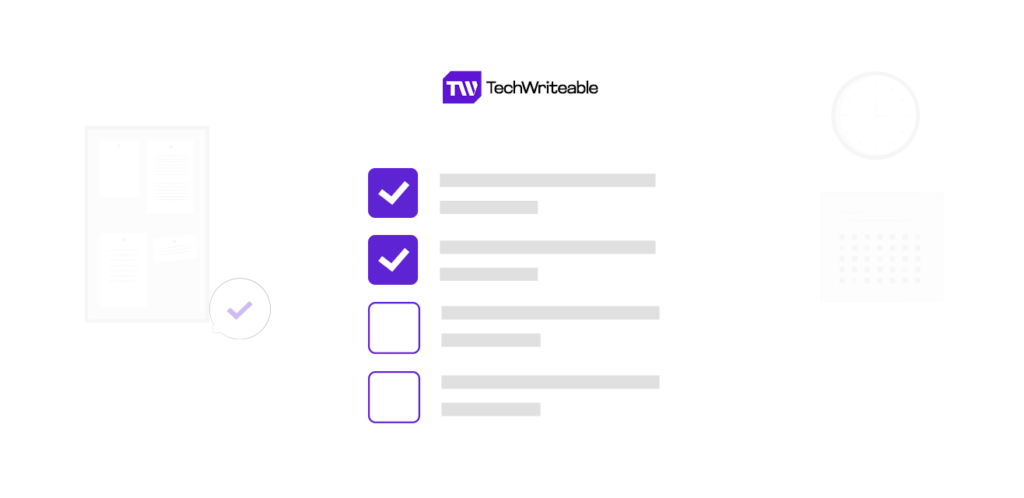Writing is one of humanity’s oldest forms of communication. Over time, people have used different writing styles and rules. However, despite the technological advancements that transformed the way we write, the fundamental laws of good writing remain unchanged.
These rules should be followed when writing an essay, report, or email to ensure the written work is comprehensive, clear, concise, and impactful. This article focuses on an exhaustive list of 20 fundamental rules of writing. Each rule comes with examples to demonstrate the rule. Let’s dive in.
The 20 Fundamental Writing Rules with Examples
If you want to improve your writing skills, you should understand the rules of writing. Here are the 20 fundamental writing rules to follow:
1. Use Proper Punctuation and Grammar
According to Macmillan Education Limited, good grammar and punctuation are the basis for effective communication. Your sentences should be punctuated properly and grammatically correct to achieve high coherence.
For instance, Compare the two sentences here:
- Incorrect: Me and him are going to the store
- Correct: He and I are going to the store.
- Incorrect: The book, that i bought yesterday, was interesting
- Correct: The book that I bought yesterday was interesting.
2. Maintain Consistent Tense
While writing, stick to using a specific tense within a sentence, paragraph, or section unless there is a clear intention to switch. This helps your reader understand and relate well to the message of your piece.
For instance:
- Incorrect: She wakes up early and made breakfast.
- Correct: “She woke up early and made breakfast”. or “She wakes up early and makes breakfast.”
3. Be Clear and Concise
When writing, you should avoid using complex terms. Try expressing your point clearly and concisely. You should not fill your texts with fluffs and convey your message straightforwardly. Check out the examples below on how you can do this:
- Phrasal words such as “unexpected surprise,” “final outcome,” and “exactly the same” are redundancies. Instead, use “surprise,” “outcome,” or “the same”.
- Wrong: I saw a tall, dark, hairy, fine boy on my way to school this morning.
- Right: I saw a handsome boy this morning.
4. Structure and Organization
The structure has to do with how you arrange your ideas. Structure and organization go hand-in-hand. Therefore, you should follow a layout of sentences and paragraphs. Ideally, start with the introduction, where you initiate the topic. Here, you can capture the reader’s attention and set the tone for the rest of the piece.
Go on with the body of the piece, where you share the main message, ideas for or against it, and examples supporting your claims if necessary. Finally, draft the conclusion, which is the piece’s final section. It summarizes the points raised in the body and provides closure to the reader.
5. Tone
The tone has to do with how your reader perceives your message. Try to use the right tone for the right piece. Know when to sound professional, friendly, stern, or persuasive. Therefore, adjust your tone based on your purpose and intended readers.
For example:
- Professional Tone: You must submit this report for approval tomorrow unfailingly.
- Friendly/Casual Tone: My friend, let’s pop the champagne!
- Persuasive Tone: We should endeavor to take immediate steps to address this issue before it gets out of hand.
6. Use Active Voice
Using an active voice when writing helps prevent fluffs. It makes your piece more direct and engaging. Avoid writing in passive voice or reduce the usage as much as possible. The position of a subject in a sentence tells whether it is active or passive. Consider the following examples:
- Passive voice: The thief was beaten by the market women.
- Active voice: The market women beat the thief.
- Passive voice: We were taken to the hospital after breakfast.
- Active voice: They took us to the hospital after breakfast.
7. Know Your Audience
Your writing will be more effective if you know and write according to your audience’s preferences and shared knowledge. Some factors you can consider include age, level of education, race, or ethnic group.
For instance, a scientific research paper has a higher technical language and detail standard than a blog post. Also, a formal report for a corporate audience will use professional language, unlike a social media post written for a younger audience, which is more casual and humorous.
8. Address Reader Objections
In writing, these are the possible reasons readers can doubt the credibility of your piece. Strongly predict the pathway of your readers’ possible doubts about the argument to make your case and credibility sure.
For example, when writing an argumentative debate essay, dedicate a section of common arguments to refute and argue how they are irrelevant to the captivating theme. For a research paper, you must discuss the research’s limitations and justify why you can nullify or counterbalance it to make things work.
9. Revision and Editing
Make sure to revise and edit your writing. Carefully review your work and look for grammar, punctuation, and clarity mistakes.
Here are a few examples:
- We decided to cancel an outdoor event that we planned for next weekend due to the fact that the weather was unfavorable.
Better version: The weather was terrible, so we had to cancel the outdoor event we planned for next weekend.
10. Citation and Referencing
These are crucial rules of writing that involve acknowledging and providing credit to the sources of information, ideas, or quotations used in your writing. There are two types of citations which include:
- In-line citation: Here, you cite sources in the body of the writing. You can cite whenever you directly quote, paraphrase, or summarize information from another source. It includes the author’s last name and the publication year in parentheses. E.g., “According to Smith (2024),” …, “Recent studies show that… (Ogundele, 2024).”
- Footnote or Endnotes: In academic writing, endnotes provide additional information and citations to sources. For example, see Olabode (2024) for a comprehensive analysis of this study.
At the end of your piece, include a list of all the sources cited in your writing. Arrange them alphabetically by the author’s last name or title. Provide detailed bibliographic information for each source to enable readers to locate them. Familiarize yourself with the appropriate citation style (e.g., MLA, APA) and follow it consistently throughout your writing.
For instance:
- Ahmed, A., Kayis, B. and Amornsawadwatana, S. (2007), “A review of techniques for risk management in projects,” Benchmarking: An International Journal, Vol. 14 No. 1, pp. 22-36. https://doi.org/10.1108/14635770710730919 (APA style)
- Zou, Patrick XW, Shouqing Wang, and Dongping Fang. “A life‐cycle risk management framework for PPP infrastructure projects.” Journal of financial management of property and construction 13.2 (2008): 123-142. (Harvard style)
11. Avoid Plagiarism
Plagiarism is a serious offense with academic and professional consequences. Strive always to avoid it while writing any piece. That is why you must provide a precise citation if you must quote another. To prevent it, cite sources, rephrase content, and acknowledge sources. Finally, always use a plagiarism checker after writing to ensure you paraphrase well.
12. Use Consistent Formatting
Maintain uniform font style, font size, and spacing in your write-up. You should also consistently use italics, underlining, or bold for emphasis. Lastly, include this information throughout your business report, technical article, or paper for publication.
13. Use Headings and Subheadings
Headings and subheadings provide maximum clarity to any piece. It makes the structure look organized and exciting to read. Use descriptive headings that reflect the content of each section.
For example:
Heading 1: Risk Management Techniques
Heading 2: Overview of Risk Management
Heading 3: Stages of Risk Management
Heading 4: Techniques of Risk Management
14. Use the Right Pronouns
Using the right pronouns ensures clarity and coherence in communication. If you are writing on behalf of an organization, use “we” and “our” to show collectivism. Use the pronouns “You” and “Your” for your readers.
For example:
- Dear customer, We are looking into the issue, and our customer support will contact you soon.
- You can subscribe to our newsletter to receive daily nuggets on nutrition and diets.
15. Give Clear Instructions
Provide explicit and easy-to-follow guides to your readers. Be specific, use action verbs, break down steps, provide context, and avoid technical language when giving instructions.
For instance:
- Incorrect: Utilize the CRM software to input customer data.
- Correct: Use the customer database system to enter their information
- Incorrect: Complete the form.
- Correct: Please fill out the attached form with your personal information.
16. Create a Content Style Guide
A consistent style guide for writing content is needed. A content style guide is a reference document that outlines specific rules, preferences, and standards for writing style, formatting, tone, and other elements.
17. Watch out for Homonyms
Homonyms are words with the same pronunciation but different meanings and spellings. Be vigilant and careful with homonyms.
For example:
- Incorrect: There classroom is dirty.
- Correct: Their classroom is dirty.
18. Avoid Double Negation
Avoid using two negative words or phrases in a sentence. Double negative words can cancel each other out and create confusion in meaning. Instead, use positive words to convey your message.
For example:
- Incorrect: I can’t disagree with you no more.
- Correct: I agree with you.
19. Capitalize the Right Words
Capitalization helps to distinguish proper nouns, indicate the beginning of sentences, and highlight headings. You can capitalize proper nouns, titles, headings, names of days, months, holidays, brand names, important events, and so on.
For instance:
- Incorrect: the president of nigeria…
- Correct: The President of Nigeria…
20. Use Grammarly or Other Tools to Proofread
Grammarly and other writing tools can be valuable guides for improving your content. They assist with grammar, punctuation, spelling, style, and clarity.
Wrapping Up
Communicating effectively and connecting with your audience requires a solid foundation in writing fundamentals. Follow this checklist of 20 fundamental writing rules to improve clarity, coherence, and impact across various contexts. Whether you are a student, a professional, or a hobbyist writer, incorporate these rules into your writing process. So, the next time you sit down to write, remember to consult this checklist.
Consult our compilation of fundamental writing rules to become a more effective and confident communicator. At TechWriteable, we provide similar guides for our subscribers. Sign up for our newsletter to enjoy premium content. Remember to share your thoughts as well. You can get a list of content related to Data Analytics, Marketing Automation, DevOps tools, and others.



